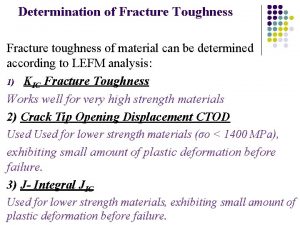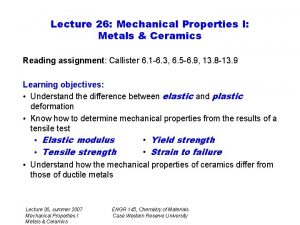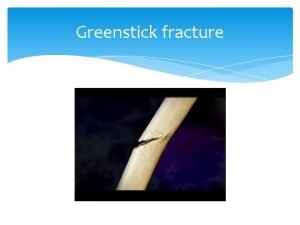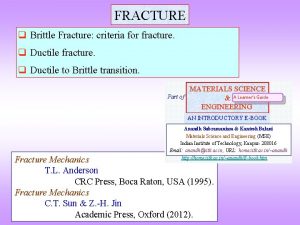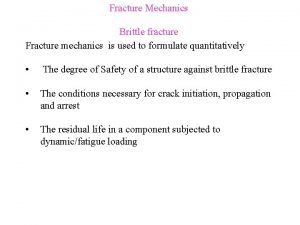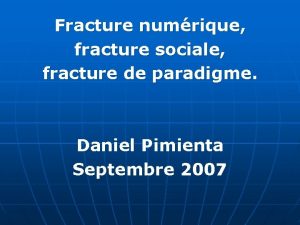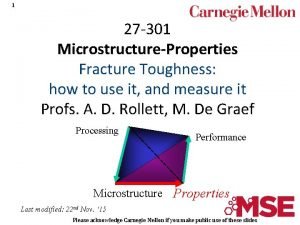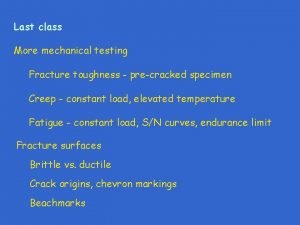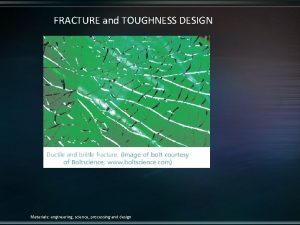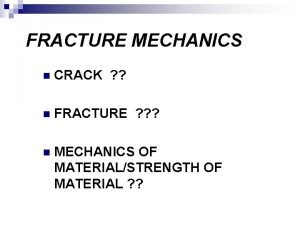Determination of Fracture Toughness Fracture toughness of material
















- Slides: 16

Determination of Fracture Toughness Fracture toughness of material can be determined according to LEFM analysis: 1) KIC Fracture Toughness Works well for very high strength materials 2) Crack Tip Opening Displacement CTOD Used for lower strength materials (σo < 1400 MPa), exhibiting small amount of plastic deformation before failure. 3) J- Integral JIC Used for lower strength materials, exhibiting small amount of plastic deformation before failure.

4) R – Curve The resistance to fracture of a material during slow and stable crack propagation. KIC fracture toughness of material is obtained by determining the ability of material to withstand the load in the presence of a sharp crack before failure.

Fracture toughness is required in the system of high strength and light weight, i. e. , high strength steels, titanium and aluminium alloys. Ex: Flaw geometry and design of cylindrical pressure vessel

Determination of KIC fracture toughness l KIC - the critical stress intensity in mode I fracture l Need to make sure that the specimen is tested under mode I fracture and in a plane strain condition. Therefore, brittle condition will be obtained. 1) Validation of KIC fracture toughness value 2) Specimen preparation 3) Testing procedure 4) Calculation of KIC value

Validation of KIC value l l Since the stress distribution under the notch varies due to specimen thickness, which also affect toughness of materials of different test specimen dimensions. Due to the criterion for brittle fracture in the presence of the notch, the plane strain condition, is required for the validation of fracture toughness KIC values. Equation *

Specimen preparation l l l Select the specimen dimensions. Select the crack propagation direction. Fatigue pre-cracking by applying fatigue load at a controlled condition of small load and amplitude to obtain a sharp fatigue pre-crack to ensure high stress distribution ahead of the crack tip.

Test procedure for KIC fracture toughness l l A pre-cracked specimen (three point bending specimen) is arranged and monotonically loaded until failure. Load and clip gauge displacement are recorded during loading to give a graph, which will be used for calculation.

Calculation of KIC fracture toughness Fracture toughness KQ is calculated using the following expression (for a bend specimen). SENB Specimen C(T) Specimen

Calculation of KIC fracture toughness If the KQ value obtained from above equation is verified according to Equation *, KIC will be obtained. Fracture toughness and design If the KIC value of material is known and the presence of a crack is allowed, we can then monitor the crack propagation during service prior to failure. How long we can use the component before it fails. Crack in the component (in service) can be detected by using Non Destructive Testing (NDT), i. e. , ultrasonic, dyepenetrant, X-ray, Eddy current, ferromagnetic inspection.

Problem 1: The dimensions and material properties of the AISI 4340 plate made of steel and containing a crack in the center are as given below. This plate has a defect of a = 1 mm as an initial crack. Calculate the stress intensity factor for the plate and the crack position as the plate is subjected to a tensile load of P = 240 N. (W = width, B = thickness, H = height. HOMEWORK 1

Problem 2: The fracture toughness of a piece of aircraft made of aluminum is 40 MPa(m)1/2. It has been identified that the fracture occurs under 300 MPa stress and the maximum internal crack length reaches 4. 0 mm. For the same part and alloy, calculate whether the fracture occurs while 260 MPa stress applied and the maximum internal crack length reaches 6. 0 mm? Why? or why not? Please explain? ?

Solution 2: Airplane parts are made of aluminum alloy. . . If we look at the definition of critical fracture toughness, to provide information about the geometry of. We can use. (Y) is the shape correction factor and it can be used to calculate KI value and after second loading the crack dimension is measured, and the resulting value is compared with fracture toughness value. In the second case fracture will occur because the value of KI is greater than the value of KIC.

DUCTILE - BRITTLE FRACTURE RELATIONSHIP WITH TENSILE TEST

If the fracture occurs in the elastic region of the traction curve, therefore as can be seen from the figure we have brittle fracture. Brittle fracture

If the fracture occurs in the plastic region of the traction curve, therefore as can be seen from the figure we have ductile fracture.

Ductile Fracture Overwiev For plastic deformation it should be σapp> σyield. However, even when (σapp) is in the elastic region the fracture can occur Ductile Fracture The stress causing the fracture is (σ). The stress causing the sliding (τ).
 Fracture toughness k1c
Fracture toughness k1c Control determination
Control determination What is mental
What is mental Workshop test for toughness
Workshop test for toughness Modulus of toughness
Modulus of toughness Strain diagram
Strain diagram Elastic compliance and stiffness constants
Elastic compliance and stiffness constants Yield strength dental materials
Yield strength dental materials Ductile and brittle fracture
Ductile and brittle fracture Useful harmful materials
Useful harmful materials Culture includes
Culture includes Whats cultural lag
Whats cultural lag Geometric symbols in engineering drawing
Geometric symbols in engineering drawing All groups create norms to enforce their cultural values.
All groups create norms to enforce their cultural values. Rsq formula in standard costing
Rsq formula in standard costing Cast-off blood spatter
Cast-off blood spatter Mood vs tone
Mood vs tone
